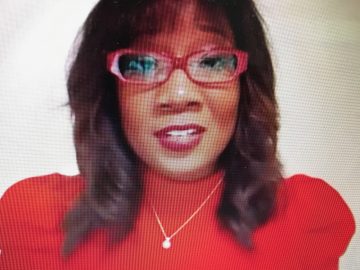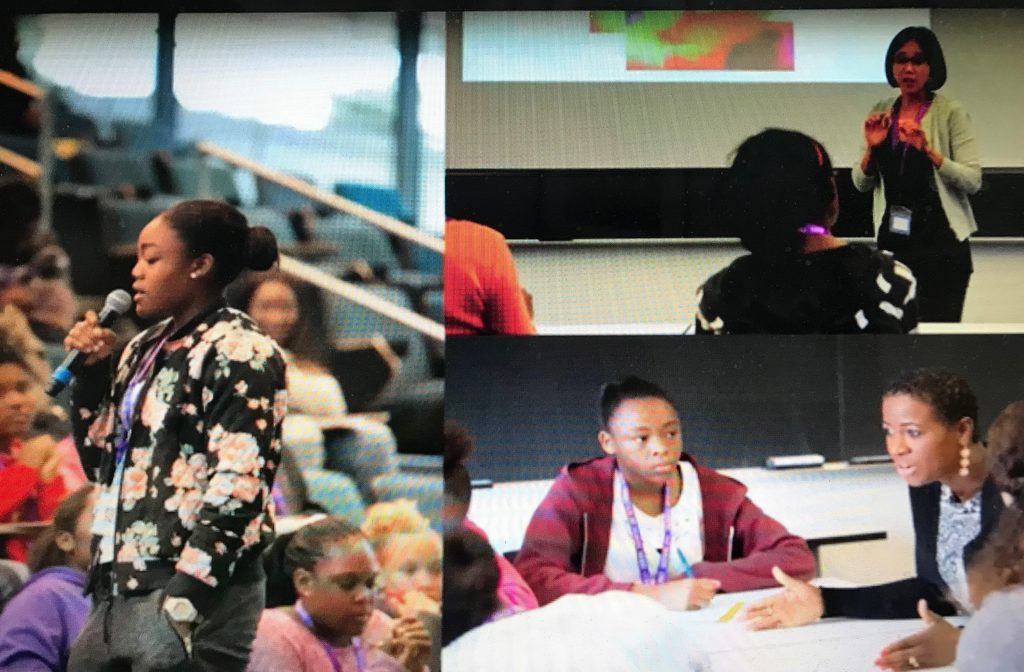By DAVID DUPONT
BG Independent News
Talithia Williams beat the odds.
The numbers show that Black women are less likely to graduate from college, never mind go on to earn a doctorate. And when it comes to teaching in college, 75 percent of the professorate is white. “The faculty has not diversified at the same level that our student body has diversified,” Williams said.
Those numbers are even more skewed against her in the mathematics.
Williams, a statistician and mathematician, she was the first woman to get tenure at Harvey Mudd College, a highly selective school of engineering and science in Claremont, California.

Through her Ted Talk, TV appearances, and books, she’s an advocate for more women and Black students to follow in her footsteps.
Williams gave the keynote address for this year’s Beyond the Dream series at Bowling Green State University on Tuesday.
Williams’ path started when she was taking pre-algebra. She was halfway through the course when she decided she wanted to move up to algebra. “I got this,” she said.
Her teacher agreed to let her try. If it didn’t work out she could return to pre-algebra. After the first six weeks in algebra, she was failing, but determined not to go back. Six weeks later she had a C, and finally moved to a B-. “So, I wasn’t exactly a stellar student but sort of caught on to what was happening. I was glad to have had that experience.
Her algebra teacher told her: “I’m glad that you persevered in sticking it out in algebra.” Williams continued: “That spoke to me because he was saying you started at a disadvantage … but you stayed in that environment, persevered and pushed yourself.”
She attended Spelman College, a historically Black college for women. This was the first time she’d seen African American women with doctorates in mathematics.
“Everyone was there to help Black women be successful,” she said. That included faculty, the janitors, the college president, and the cafeteria worker who expressed concern that she wasn’t eating enough. “The entire community was invested in your success.”
From there she started a doctoral program in bio-statistics at Howard University. She fell in love with the statistics so she transferred to a statistics program at Rice, where she received her PhD.
Williams wants others to follow in her footsteps.
The data she shared showed how difficult that is in the American educational system.
“Until we understand the data, we don’t know how to make a difference, where to make a change.”
Aside from white men and Asians, all other groups are underrepresented in science and engineering fields.
African Americans represent 13 percent of the population, but only 5 percent of those jobs. Though women make up about half the population they are underrepresented in all science and technology fields, except for biology.
Their representation has even declined in math and statistics, and dramatically in computer science where they are just under 40 percent of the workers in 1985, and by 2010 were about 15 percent. This is strange, Williams said, because of the pivotal role of females as “human computers” in the early years of the field. That highly detailed activity was “almost considered women’s work.”
Women are equally underrepresented in physics and engineering.
As of 2014, 22 percent Black U.S. residents 25 or older had earned a bachelor’s degree or more, while 36 percent of White residents had. For Hispanics, that rate was 15 percent and for Asians, 52 percent.
“Education,” Williams said, “brings access and opportunities, and also moves people from lower income brackets to higher income backets.”
In all ethnic groups, having a bachelor’s degree or more, accounts for annual incomes of $20,000 more a year over the average. African Americans and Hispanics still lag White residents and Asians by $15,000 to $20,000 a year.
This stark income inequity plays into who is likely to graduate from college. In 2013, 77 percent of the dependents in families in the top quarter of income earners had earned a degree. That’s more than double the 34 percent in families in the next quartile down, which is twice what the graduation rate for those in the next lower quartile of earners. For those in the bottom 25-percent the graduation rate is 9 percent.
The good news, she said, is “the data overwhelmingly show that for students who complete college it drastically improves upward mobility.” Of those in the bottom 20 percent, completing college means an increase in income status for 90 percent, with 10 percent able to reach the top 20 percent of earners.
“We see that if you complete college, especially for low income students, it drastically changes the outlook for not just for that generation but for future generations,” she said.
To make that happen colleges and society need to make adjustments.
One would be to stop relying on property taxes to fund K-12 education. Students’ access to quality schools and opportunities should not be determined by their zip code, she said.
Americans must recognize that making the systemic changes needed is going to take time, money and political capital.
Williams urged college administrators to take a hard, honest look at data. Having an 80-percent graduation rate may be something to brag about, but a 25-percent graduation rate for underserved students is not going to be reported.
Academics must also respect and nurture the aspirations of students. They should not discourage a student because of their perceived lack of background, nor ask them to settle for another career path considered less rigorous.
“ “The onus is on us. We just can’t blame that K-12 experience,” Williams said. “How can I help you get the dream you want.”
Resources should be based on who has the greatest need, she said. Too often scholarships that are awarded based on merit are actually just a reflection of the income of the student’s family.
Colleges need to make students feel as welcomed and supported, as Williams’ herself felt at Spelman.

Individuals can also take action by partnering with others in the community and on campus.
Working with the non-profit Sacred Sistahs, local schools, and several offices at Harvey Mudd, Williams launched a STEM conference for Black young women in middle and high. The 11-year-old conference offers a chance for girls to come to the Harvey Mudd campus and experience STEM disciplines first hand.
Williams recruited student volunteers to help run the program. Those students saw themselves in the young women attending the conference. They’d ask what Advanced Placement and International Baccalaureate classes the high school students were taking. But the young women didn’t know what they were talking about. Their schools didn’t offer these high level courses.
The college student volunteers learned that based on zip code alone, these conference attendees “don’t have the same access that may get them into a place like Harvey Mudd even though they have the same passion, and they are just as inquisitive.”
Williams shared a quotation from a parent who said: “I most enjoyed seeing the excitement and wonder in each young woman as they sat at the footstools of women who are practicing and actualizing their dreams.”
Williams concluded: “This is what takes us beyond the dream, this is what moves us from a place of complacency, of systemic oppression, to a place of equity and equal access in higher education.”

